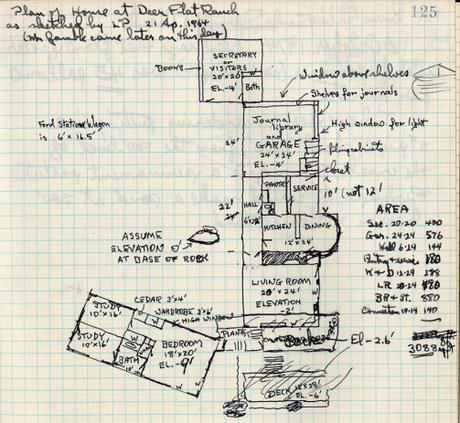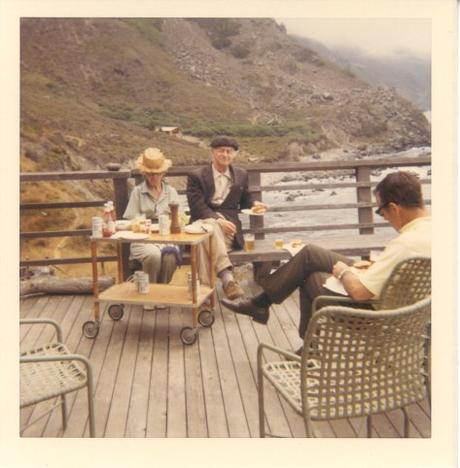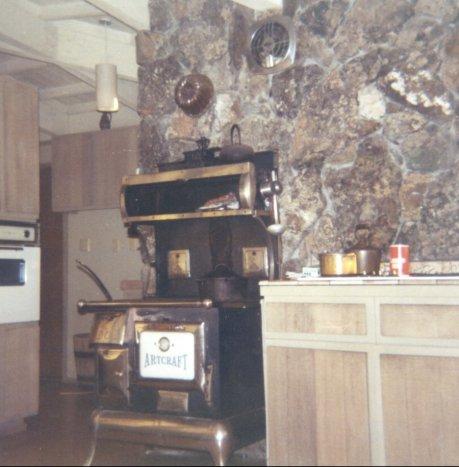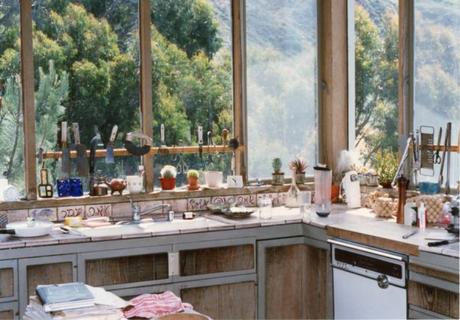
Pauling’s schematic of the Big House at Deer Flat Ranch, April 1964.
[The story of Deer Flat Ranch, part 3 of 3]
Linus and Ava Helen Pauling stayed in the Old Cabin when at Deer Flat Ranch from 1956 to 1964, and during much of this period, visiting family members would often sleep in the barn. By 1961, a pre-designed kit home had been constructed for guests to use. Located down the gorge from the barn, at the foot of Salmon Cone, the house came to be called China Camp, named after the adjacent beach.
That same year, Pauling began conversations with Dr. Gustav Albrecht of Caltech, a former student of Pauling’s, about acting as chief architect on the design of a new home on the property. Albrecht worked with John Gamble Associates and, once construction began, lived in the Old Cabin for several months to supervise the building according to Pauling’s specifications.

A view of the Big House near its entryway.
By 1964, the “Big House” was complete. It was an unorthodox home, filled with angled windows of multiple types that offered numerous views of the Pacific Ocean. The home likewise featured dueling his and hers studies, as well as a garage that was specifically built to shelter a car while also housing Pauling’s collection of scientific journals. Book cases were everywhere and, as time moved forward, the decor came to be dominated by framed honorary doctorates lining the hallways and mounted in every room. A massive stone fireplace separated the kitchen from the living room, and a large, westward-facing deck became a focal point for social gatherings. The unusual space proved difficult to maintain, but for the Paulings it was heaven on earth nonetheless.

Looking southwest from the living room.
The Big House was built at the end of a new road that had been bulldozed from the Old Cabin west to a nearby glade that the Paulings called “Eucalyptus Hollow.” By the time that most of the construction was completed, excavations on the Pauling land had revealed that a small village of Salinan Indians, dating back thousands of years, had once been located in the area where the Big House was built. More artifacts were discovered under the Old Cabin, which was rebuilt and, a decade later, joined by a new caretaker’s house. Pauling held on to several of the Salinan artifacts as well as a small collection of human remains, all of which were repatriated once Pauling’s papers were donated to Oregon State University.
Kids and grandkids visiting during and immediately following the construction, and were often volunteered to perform various duties on the property. Linus Pauling Jr., his wife Stephanie, and Stephanie’s daughter Carrie were frequent visitors throughout the 1970s. During this time they assisted in finishing floor moldings and tiles at the Big House, which sported a decorative copper diving screen based on the mezzanine foyer in Dulles National Airport, as well as a specially made copper roof.

Dining on the deck, 1971.
The Big House was as a sanctuary, and it was understood that even family visitors were not to barge in unannounced. Rather, Ava Helen would run a dish towel up a nearby flagpole when she was ready to receive visitors, usually in the late morning.
During visits with family, Pauling tended to focus his conversation on scientific matters, while it was Ava Helen who worked to bring the family together, particularly relishing her role as a grandmother. Catching fish from the Pacific Ocean and cooking under gas lights in the wilderness of California’s coastal forests, visitors often felt a sense of living in the pioneer past. Linus and Ava Helen reveled in this sensation themselves, and after 1966 they were spending fully half of their time at the Big House.

Ava Helen’s Artcraft stove.
With advancing age came thoughts of retirement, and Linus and Ava Helen began to imagine that they might move to the ranch full-time by Pauling’s 70th birthday, or perhaps his 75th. Pauling was, unsurprisingly, consistently non-committal about the idea of giving up his career in science, no matter how old he grew. The ranch, however, offered an appealing happy medium where he could continue to pursue a scientific agenda while lessening the pace and clutter of his very public life.
By 1976, when Ava Helen was diagnosed with cancer, the pair seemed to treasure their time at Deer Flat Ranch all the more; Ava Helen took up the guitar and bought a grand piano, and children and grandchildren came to visit often. Pauling, however, could never truly be removed from science, and spent much of his time at the ranch working on theoretical papers.

The view from the kitchen.
A year later, Pauling looked to be making good on notions of retirement, and was considering removing himself from day-to-day operations at the Linus Pauling Institute of Science and Medicine, which Art Robinson was leading as president. However, an administrative battle with Robinson that arose over the future of the Institute provided Pauling with a compelling reason to remain highly involved, and he never did fully extricate himself from administrative duties at the Institute that bore his name.

Ava Helen and Linus in their living room, celebrating their fiftieth wedding anniversary, June 1973.
In retrospect, it seems unlikely that a man of Pauling’s industry, interests and ego could ever remove himself completely from the world of science and retire to the ranch full time. Indeed, after Ava Helen passed away in 1981, he ramped up his scientific program, working both at the ranch and in Palo Alto, California for the remainder of his life.
As he grew older, the rustic pioneer charm of the ranch faded somewhat for Pauling. The land around the gas service station was found to be eroding at an alarming rate, and it was eventually abandoned. Likewise, the number of cattle and ranch hands slowly dwindled. Eventually, only a single caretaker remained on the property, Steve Rawlings, who also acted as Pauling’s personal nurse during his final years.
Nonetheless, Pauling continued to spend a majority of his time at the property, reading, writing, and dreaming of a peaceful world guided by the light of scientific reason. It seems fitting then that when Linus Pauling passed away, in August 1994, it was in the Big House at Deer Flat Ranch, surrounded by his family.
